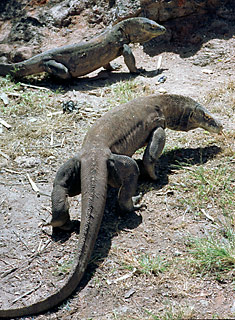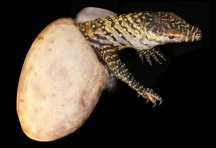A virgin birth is a key part of the Christmas story. Now, scientists have found that two Komodo dragons in English zoos have done the same. This ability helps dragon populations to recover in the wild, but it may push the remaining few closer to extinction.
According to Christian lore, Mary gave birth to baby Jesus without ever having had sex with Joseph. A biologist might describe this with the unwieldy word ‘parthenogenesis’, the Greek version of the more familiar term ‘virgin birth’(‘parthenos’ means virgin, and ‘genesis’ means birth.)
The New Testament aside, shunning fertilisation and giving birth to young through parthenogenesis is rare among higher animals, occurring in only one in every thousand species. Nonetheless, in a few short weeks, eight more virgin births are expected in the English town of Chester. The mother is called Flora, and she is a komodo dragon.
 Komodo dragons are an endangered species in their island homes of Indonesia. Fifty-two zoos around the world co-operate in a dedicated breeding programme that aim to boost the natural populations of these largest of lizards.
Komodo dragons are an endangered species in their island homes of Indonesia. Fifty-two zoos around the world co-operate in a dedicated breeding programme that aim to boost the natural populations of these largest of lizards.
In Europe, only two female dragons, both living in England, are sexually mature. One of these, Flora, lives at Chester Zoo where she has laid a clutch of 25 eggs despite never having been kept with a male.
Three of Flora’s eggs tragically collapsed while they were being incubated, but this provided Phillip Watts and colleagues from the University of Liverpool to trace their origins. They analysed the genetic make-up of the lost eggs using genetic fingerprinting and found that their genomes matched those of their mothers.
Children born through sex have two copies of every gene, one inherited from their father and one from their mother. But in the case of Flora’s babies, all of their genes were identical, suggesting that they all came from Flora alone.
 Watts found a similar situation in London Zoo, where a late female called Sungai had given birth to four healthy dragon-lings (see left, image courtesy of Ian Stephen/Nature), over two years after she lost contact with a male.
Watts found a similar situation in London Zoo, where a late female called Sungai had given birth to four healthy dragon-lings (see left, image courtesy of Ian Stephen/Nature), over two years after she lost contact with a male.
Scientists had suspected that the babies were the result of sperm that Sungai had stored during that time, but genetic tests confirmed that she was the sole parent.
This double-sighting of parthenogenesis in Komodo dragons suggests that this unusual strategy is not so unusual in these lizards. It could even be used to help populations weather hard times.
Komodo dragons have Z and W chromosomes, rather than our Xs and Ys and in their case, it is the ones with a matching pair who are males (ZZ or WW), and the ones with a dual set who are females (WZ). As a result, parthenogenetic dragons are always male and when populations dwindle, they can kick-start numbers by mating with their own mothers.
This strategy could cause large problems for conservationists. By causing all an individual’s gene pairs to be identical, parthenogenesis achieves what inbreeding usually takes generations to do.
In rare cases, it could help struggling populations to recover, but if dragon numbers become so small that parthenogenesis becomes the norm, reduced genetic diversity could push the species further towards extinction
Zoos need to take heed as well. Females are usually kept apart from males, who are transferred between zoos to act as reptilian studs. This reduces the risk of aggression on the part of the larger males, but it could lead to a excessive number of virgin births.
Clearly, the key to saving this magnificent animal is more research into how best to account for its new-found ability, and breed a healthy diverse population.
More about animal sex and reproduction:
Butterflies evolve resistance to male-killing bacteria in record time
When the heat is on, male dragons become females
Chimerism, or How a marmoset’s sperm is really his brother’s
Aphids get superpowers through sex
Reference: Watts, Buley, Sanderson, Boardman, Ciofi & Gibson. 2006. Nature 444: 1021-1022.
Technorati Tags: komodo dragons, virgin birth, parthenogenesis, zoos, breeding programmes, science
Filed under: Animal behaviour, Animal kingdom, Conservation, Genetics, Reptiles & amphibians, Sex |











the dragon de comodo is very intresting. together is fabulous.
[…] many animals, from aphids to Komodo dragons, can reproduce asexually from time to time, it’s incredibly rare to find a group that have […]
omg. Komodo dragons do incest. lmao.
Komodo dragons rock. Just coz they do. 😀
komodos rock so hard thats amazing how life does these things
this is so kl because one of the Komodo dragon chitsan gave birth with out any mating and that is a true story because i saw that happen and my fahter works there also
cool is what i say
I would want to have more information about Komodo for I learn more about it. I also want to know another webside for the Komodo information.
THANK YOU,SO MUCH!!!!!!!!!!!!!!!!!
Sincerely, Your friends. That We Love You!!!!!!!!!!!!!!
Ely Martinez, Zico, Jaqueline Martinez, and Omar Bravo
esto es muy exelente por que podemos ver una nueva especie busca en interned y envia a tus amigos esta nueva informacion intenta que esta nueva especie sea conocida a todos busca gracias